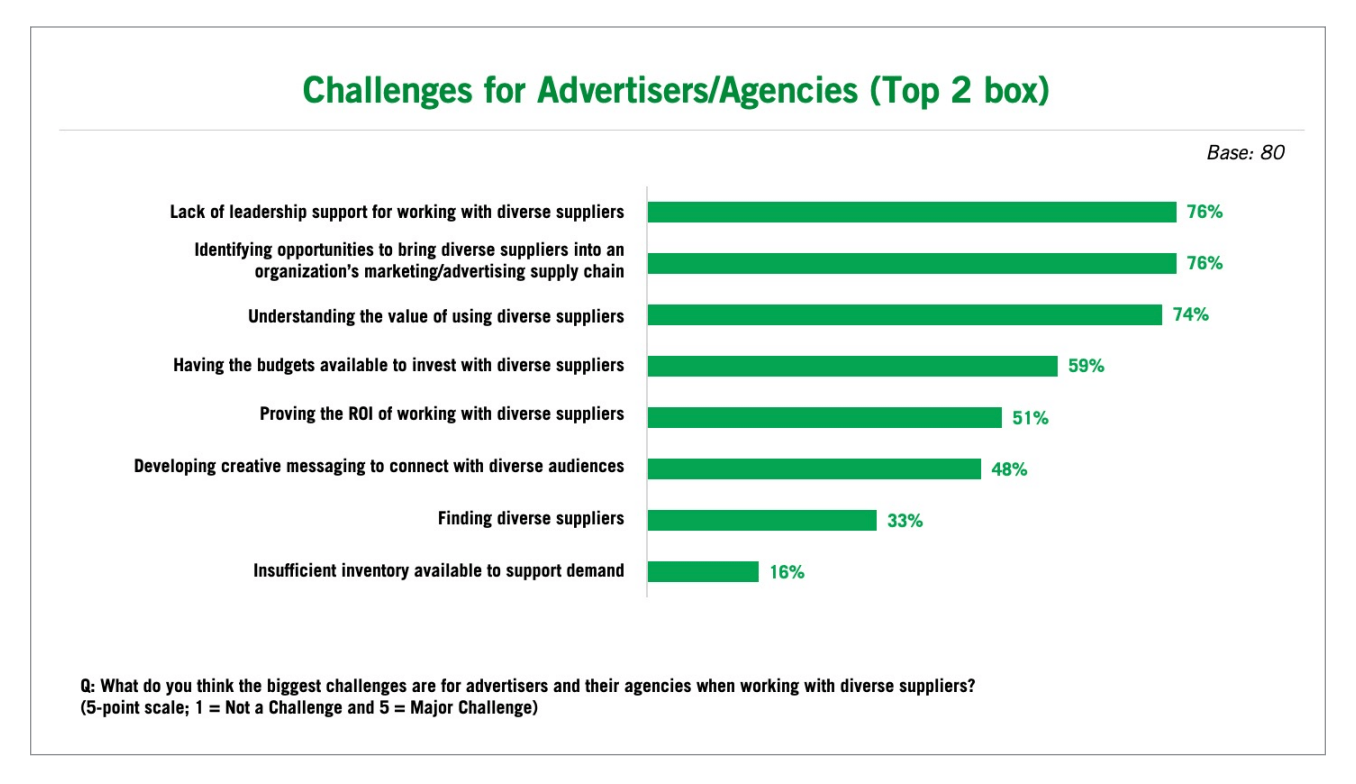Prioritizing diversity, equity, and inclusion (DE&I) is crucial in all aspects of your business, and media buying is no exception. From a purely business standpoint, the advantage is obvious: working with media suppliers that prioritize DE&I can pay dividends for your brand by helping you reach and make authentic connections with diverse groups of customers.
Many advertisers have expressed their intention to invest in diverse media buying in recent years but that intent hasn’t always translated into actual action: according to a survey by the Association of National Advertisers (ANA), 56% of diverse media suppliers indicated that interest in supporting diverse suppliers was on the rise between 2021 and 2022, but only 38% indicated they received increased investment from the marketing/advertising communities.
To successfully manage and scale DE&I investments, brands need to make inclusive considerations an integral part of their overall strategy by identifying and accessing brand-suitable inventory and media vendors, leveraging the right data to prove efficacy, and creating a long-term plan to meet their DE&I goals over time.
Setting your brand up to win with DE&I goals and specific media planning
Some businesses might be concerned about efficacy when buying more diverse inventory, but that’s a red herring: you can achieve DE&I goals in your media buying strategy without sacrificing performance.
A good first step towards supporting DE&I is shifting media dollars to media with minority, LGBTQ+, or female owners, among other groups. This media spend means you can still be present in premium environments while reaching audiences that are more likely to be engaged than the general population would be in an activation.
But before jumping into changing your media spend, make sure you’ve taken the time to set specific goals for DE&I supply investment and that your team has a good plan and timeline for how to achieve them.
Start with specific media planning to ensure that your campaign activation aligns with the community it’s intended to support. You should make sure that the teams working on this media planning are diverse; including the perspective of people who identify with the communities you want to reach is key to ensuring your media approach is effective and resonates with the audience.
Investing in DE&I media vendors and reaching the right audiences for your campaign
Once you’ve set your goals and have an overall plan in place, it’s time to take action. That starts with finding media suppliers to support your DE&I initiatives.

Source: ANA
While some advertisers have said that it’s challenging to find enough diverse-owned media outlets to meet DE&I spending goals, there are plenty of opportunities to buy this inventory if you know where to look.
One great way for advertisers to find media vendors is through planning tools like Basis, that offer lists of publishers and indicators for diverse supply, or curated suppliers like Magnite, which support DE&I ambitions in the programmatic ad buying ecosystem.
Staying up to date with media partners through industry events like IAB Newfronts can also open up opportunities or spark ideas for advertisers. The most recent showcase included diverse suppliers including LatiNation, Revry, MyCode, and Estrella Media, among others.
For advertisers running programmatic campaigns, activating media in DEI inventory can be even easier–it’s as turnkey as setting up a PMP with major suppliers like OpenX and Pubmatic.

Source: Revry
Beyond finding suppliers to work with, it’s also essential to reach the right audiences with your campaigns. That can be a challenge, since it’s hard to target ads to specific diverse groups with insufficient or inaccurate data.
Audience segments are available from major data sources, but the data costs can be on the higher cost-per-mille (CPM) end and the loss of data signals due to privacy compliance may be prohibitive.
Using first-party data is one solution to this problem, but scaling campaigns with that data might be difficult, requiring clean rooms to model known audiences against a publisher’s users to find lookalike audiences. Balancing this approach with curated private marketplace deals (PMPs) for DE&I audiences can make these efforts more efficient. Choosing specialized publishers by leveraging PMPs will help you build out accurate audiences.
Long-term maintenance and proving the efficacy of diverse media buying
Investing in a more diverse media buying strategy isn’t a one-time effort–advertisers need to make a long-term commitment. This is essential not just in terms of your business goals, but to support underrepresented publishers so they receive the funds they need to continue building the community.
Businesses should make a conscious effort over time to spend on DE&I supply as an evergreen part of their marketing strategy. Marketers should also revisit their DE&I goals regularly to evaluate how their strategy is working and make any adjustments to improve efficiency.
In the long term, you can’t forget to prove the efficacy of diverse media buying and make it as efficient as possible. For branding campaigns, you can apply a brand lift study to measure the campaign’s lift in awareness and other metrics. Larger lift studies to measure attitudes can also be good indicators of changing perceptions of the community the campaign is intended to reach. Since campaigns may not be 100% tagged/trackable, you can also track social listening and engagement to get an idea of how your followers feel about the activation.
Marketers can also improve efficacy by leveraging supply path optimization (SPO) to reduce the hurdles for the platform to connect to the end user, making it easier to access diverse inventory and audiences. SPO can also help brands find efficiencies in media spend and other factors like reducing carbon emissions.








Responses